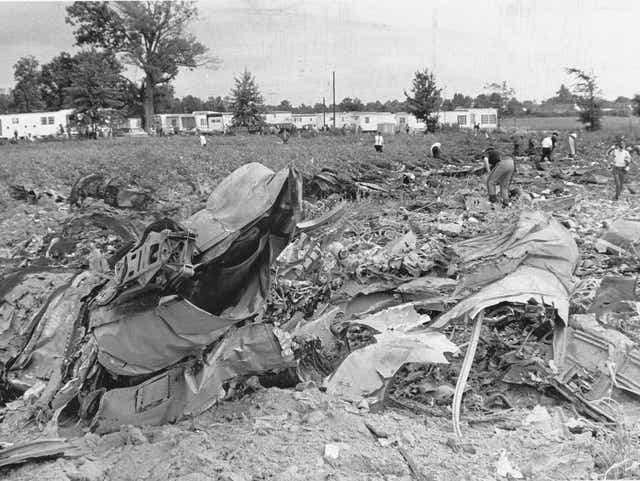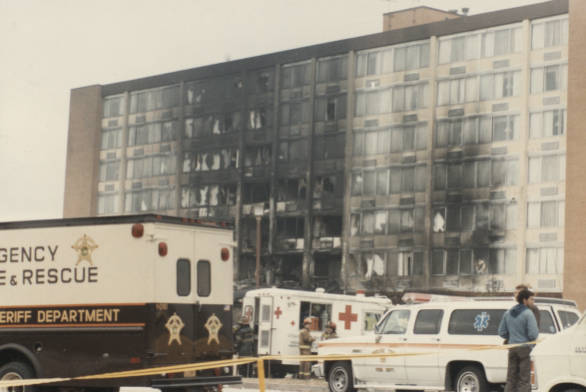Indianapolis has witnessed over 100 air crashes since came to the city in the early 20th century. The earliest known airplane accident occurred during June 1910, Indianapolis Aero Meet, the first licensed air meet in the United States. One of the “daring birdmen” crashed upon landing at the field, and his plane burst into flames. A nearby group of pilots and “mechanicians” immediately pulled the uninjured pilot from the wreckage.

Military aircraft have been involved in numerous area crashes, the first at Schoen Field on October 3, 1926. An Indiana National Guard training plane spun in over the field, killing the pilot and seriously injuring a passenger.
The city’s first commercial aircraft accident was at on November 2, 1929. An Embry-Riddle mail plane, making a normal approach for landing, apparently suffered a control failure and suddenly nosed over and crashed. The pilot was killed and the plane burned beyond repair. One passenger was killed when a Transcontinental Air Transport Ford trimotor hit a tree stump while landing at Stout Field in a blinding snowstorm on December 22, 1929. The plane, ironically christened City of Indianapolis by the airline, was repaired and continued in regular service.
Several dramatic private plane crashes occurred throughout the years. Probably the most spectacular took place on July 8, 1933, a small craft approaching Hoosier Airport for landing became entrapped in high-tension lines. When the plane hit, gasoline spilled by the impact was ignited by the lines, resulting in the plane’s catching fire and burning to its metal frame. Miraculously, the two women aboard the craft were not electrocuted because the 33,000-volt line automatically cut off on impact. They were able to climb out and drop some 25 feet to the ground, surviving with burns and broken bones.
Just a week before, on July 1, a Bendix coast-to-coast air race pilot was killed on takeoff from Indianapolis Municipal. Losing control of the plane just after rising from the runway, the aircraft flipped inverted, then slid upside-down along the runway for some 200 yards. The pilot died two days later.
The most bizarre of all Indianapolis accidents was the November 14, 1948, ground collision of two Indiana Air National Guard planes at Stout. Two fighter aircraft in takeoff formation were still on the runway when the wingman’s plane overran the leader’s. The leader was killed, and his plane ran wild around the airport until it could be stopped by shooting out the tires.
The Indianapolis metropolitan area experienced its worst air disaster on September 9, 1969, when an Allegheny Airlines DC9 and a private plane collided in midair over , just southeast of the city. Bodies and parts from the larger plane struck several mobile homes in a nearby court, but none of the residents or any of the students in two loaded school buses in the court were injured. The crash, apparently caused by pilot error, took the lives of 78 passengers and 4 crew in the airliner and the solo pilot of the private plane.

Another mid-air collision occurred on September 11, 1992, just north of Greenwood Municipal Airport, when a business plane took off and collided with an inbound smaller plane. Apparently neither pilot saw the other plane, despite the clear weather. Four well-known community leaders—, , , and —were aboard the business plane. They and the pilots of both planes died, although two passengers in the small plane survived.
A major tragedy occurred on October 20, 1987, when an Air Force jet fighter crashed into a Ramada Inn east of . The plane’s engine had flamed out some 15 miles southwest of the city, and several restart attempts failed. The pilot called Indianapolis air traffic controllers for his exact location (he was at 31,000 feet in the clouds) and was given a course to Indianapolis International. His options were to try for an Indianapolis landing or abandon the plane over open areas southwest of the city. Electing Indianapolis, he broke out of the clouds just short of the field and tried to set up a landing pattern. When he saw that he could not make the runway, the pilot headed the plane away from buildings to the east. By this time the plane was sinking far too rapidly, so he pointed it toward an open area and ejected. However, the plane swung off his planned course and crashed into the front of the hotel, where it exploded and burned, killing nine hotel employees. Fortunately, the building was nearly empty, since most of the guests had checked out earlier that morning, thus preventing many more casualties.

In May 1997, Conseco Insurance executive Lawrence Inlow was killed upon exiting a helicopter at the Indianapolis International Airport. He was struck by a moving rotor blade while walking around the front of the craft as it was shutting down, instead of exiting in a straight line away from the rotors.
CITE THIS ENTRY
APA:
Marlette, J. (2021). Aircraft Accidents. Encyclopedia of Indianapolis. Retrieved Jan 6, 2026, from https://indyencyclopedia.org/aircraft-accidents/.
MLA:
Marlette, Jerry. “Aircraft Accidents.” Encyclopedia of Indianapolis, 2021, https://indyencyclopedia.org/aircraft-accidents/. Accessed 6 Jan 2026.
Chicago:
Marlette, Jerry. “Aircraft Accidents.” Encyclopedia of Indianapolis, 2021. Accessed Jan 6, 2026. https://indyencyclopedia.org/aircraft-accidents/.

Help improve this entry
Contribute information, offer corrections, suggest images.
You can also recommend new entries related to this topic.